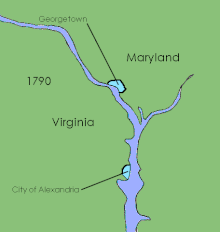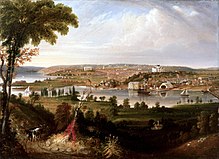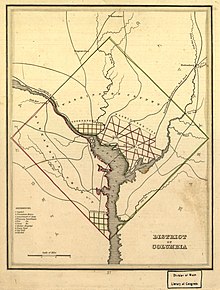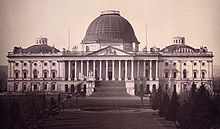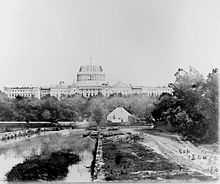History of Washington, D.C.
The McMillan Plan of 1901 helped restore and beautify the downtown core area, including establishing the National Mall, along with numerous monuments and museums.
Following World War II, many middle-income whites moved out of the city's central and eastern sections to newer, affordable suburban housing, with commuting eased by highway construction.
The assassination of Martin Luther King Jr. in Memphis, Tennessee on April 4, 1968, sparked major riots in chiefly African American neighborhoods east of Rock Creek Park.
The 1973 District of Columbia Home Rule Act provided the local government more control of affairs, including direct election of the city council and mayor.
[13] The following day, Elbridge Gerry of Massachusetts motioned "that buildings for the use of Congress be erected on the banks of the Delaware near Trenton or of the Potomac, near Georgetown, provided a suitable district can be procured on one of the rivers as aforesaid, for a federal town".
[18] The selection of the area around the Potomac River, which was the boundary between Maryland and Virginia, both slave states, was agreed upon between Madison, Thomas Jefferson, and Alexander Hamilton.
[23] Pursuant to the Residence Act, President Washington appointed three commissioners (Thomas Johnson, Daniel Carroll, and David Stuart) in 1791 to supervise the planning, design and acquisition of property in the federal district and capital city.
L'Enfant's broadest "grand avenue" was a 400-foot-wide (122 m) garden-lined esplanade, which he expected to travel for about 1 mile (1.6 km) along an east–west axis in the center of an area that the National Mall now occupies.
[51] After L'Enfant departed, Ellicott continued the city survey in accordance with his revised plan, several larger and more detailed versions of which were also engraved, published and distributed.
Dolley Madison, the first lady, or perhaps members of the house staff, rescued the Lansdowne portrait, a full-length painting of George Washington by Gilbert Stuart, as the British approached the Mansion.
[61] The aftermath of the war kicked off a mild crisis, with many northerners pushing for a relocation of the capitol with a vote brought to the floor of Congress proposing the removal of the government to Philadelphia.
On April 14, 1865, just days after the end of the Civil War, Lincoln was shot in Ford's Theatre by John Wilkes Booth during the play Our American Cousin.
[70] In response to the poor conditions in the capital, Congress passed the Organic Act of 1871, which revoked the individual charters of the cities of Washington and Georgetown, and created a new territorial government for the whole District of Columbia.
[73] In 1874, Congress abolished the District's territorial government and replaced it with a three-member Board of Commissioners appointed by the President, of which one was a representative from the United States Army Corps of Engineers.
Originally an expansion of Tiber Creek, the canal connected the Capitol with the Potomac, running along the north side of the Mall where Constitution Avenue is today.
They were also strongly influenced by the City Beautiful movement, a Progressive ideology that intended to build civic virtue in the poor through important, monumental architecture.
Several of the Commission members, including Daniel Burnham and Frederick Law Olmsted Jr. had in fact participated in the 1893 World Columbian Exposition, which was widely popular and helped to spread interest in the City Beautiful movement.
The McMillan Plan, in many respects, was an early form of urban renewal that removed many of the slums that surrounded the United States Capitol, replacing them with new public monuments and government buildings.
Although the McMillan Plan resulted in the demolition of some slums in the Federal Triangle area, substandard housing was a much larger problem in the city during the early 1900s, with large portions of the population living in so-called "alley dwellings.
[89] In July 1919, whites, including uniformed U.S. Armed Forces sailors and soldiers, attacked blacks in Washington during Red Summer, when violence broke out in cities across the country.
[93] World War II brought further population increases—more than 300,000 between 1940 and 1943—and a significant housing shortage, as existing residents were urged to rent rooms to the influx of Federal staffers who arrived from throughout the country.
[98] When the city's Board of Education began building the John Philip Sousa Junior High, a group of parents from the Anacostia neighborhood petitioned to have the school admit black and white students.
In the wake of this and the landmark 1954 Supreme Court case Brown v. Board of Education, the Eisenhower administration decided to make D.C. schools the first to integrate, as an example to the rest of the nation.
In the postwar years, whites who were better established economically began to move to newer housing in adjoining states in the suburbanization movement that occurred around most major cities.
Following King's assassination on April 4, 1968, in Memphis, Washington was devastated by the riots that broke out in the U Street neighborhood and spread to other black areas, including Columbia Heights.
The first 4.6 miles (7.4 km) of the Washington Metro subway system opened on March 27, 1976, following years of acrimonious battles with Congress over funding and highway construction, including a rejected proposal to build a north-central freeway.
Councilmember Adrian Fenty defeated Council Chairwoman Linda Cropp in that year's Democratic primary race to succeed Williams as mayor and started his term in 2007.
Mayor Gray won the general election and assumed office in January 2011 with a pledge to bring economic opportunities to more of the city's residents and under-served areas.
An FBI and DOJ investigation determined the likely culprit of the anthrax attacks to be Bruce Edwards Ivins, a scientist, but he committed suicide in July 2008 before formal charges were filed.
When U.S. forces in Pakistan raided a house suspected of being a terrorist hideout, they found information several years old about planned attacks on Washington, D.C., New York City, and Newark, New Jersey.

